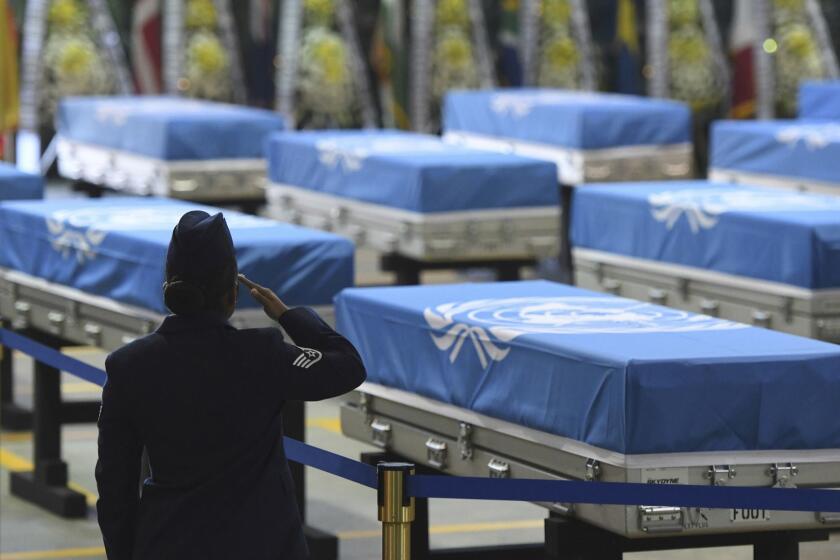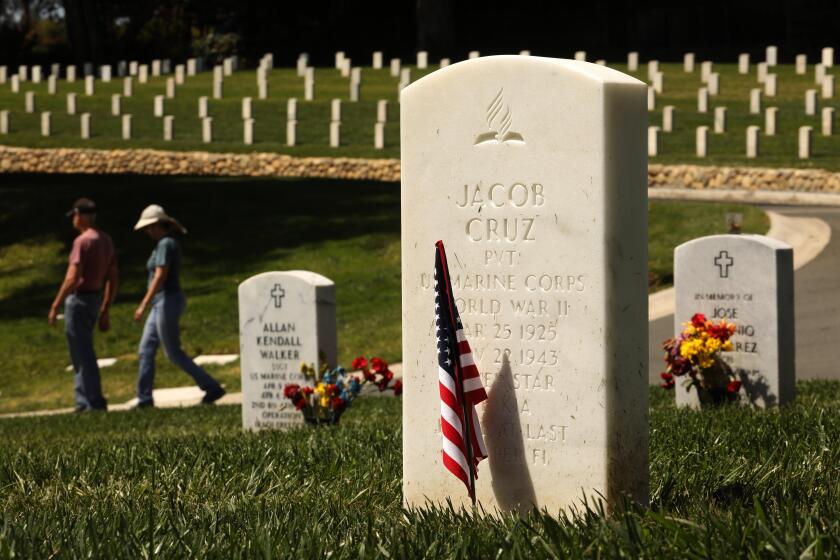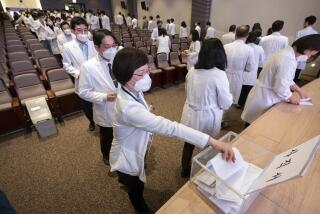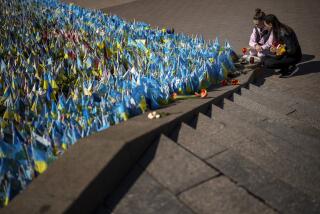South Korea in an uphill battle to recover Korean War remains
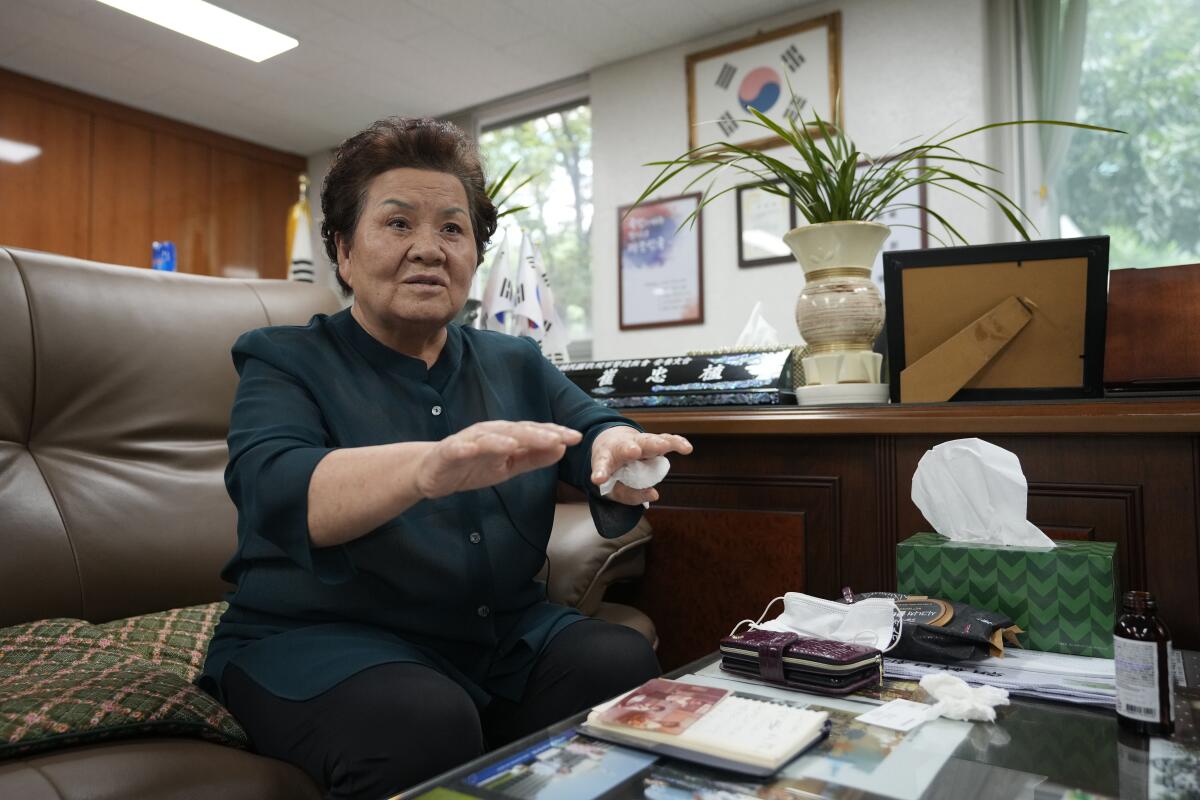
- Share via
ANYANG, South Korea — On the first day of each month, Kwak Geum-ja makes a pilgrimage to a Korean War memorial in her neighborhood to pray for her father, a South Korean soldier who died in battle when she was just a baby.
His remains have yet to be recovered, and the aging Kwak is eager for them to be found and interred at the national cemetery.
“I’m over 70 now. I won’t have any regrets in my life if I recover my father’s remains before I die,” a teary-eyed Kwak said during an interview in the city of Anyang, just south of the capital, Seoul. “I just want to see and confirm them with my eyes. Nothing more.”
Kwak is among the tens of thousands of South Koreans hoping the remains of their loved ones — soldiers who perished during the 1950-53 Korean War — will be found.
There’s still a long way to go.
Since recovery efforts modeled after a similar U.S. mission began in earnest more than 20 years ago, authorities have unearthed thousands of sets of remains believed to be deceased South Korean soldiers, but have only been able to identify 166 of them. The number of unrecovered South Korean soldiers stands at about 120,000.
South Korea has so far collected DNA samples from blood relatives of only about 47,000 slain soldiers to compare with DNA extracted from exhumed bones.
The conflict, which pitted South Korea and U.S.-led U.N. forces against North Korea and China, killed 1 million to 2 million people, including 160,000 South Korean soldiers.
Finding their remains is an urgent, emotional task because most of the bereaved relatives are either elderly or have already died.
The recovery work is complicated by the fact that many South Korean soldiers were sent to the front without military identification during the war’s opening phase, as the South rushed to blunt the surprise North Korean invasion. Authorities also didn’t keep most soldiers’ dental records, chest X-rays and other forms of ID. Once the conflict ended, rapid reconstruction and land redevelopment projects followed, making it difficult to locate some former battlefields and burial sites.
Tens of thousands of North Korean women have been trafficked into forced marriages in China and give birth to stateless children. The mothers face a fraught choice between their children or their freedom, a choice that continues to haunt many.
“It would be more meaningful for bereaved families to get back their loved ones’ remains when they are still alive. That’s our fundamental yet most difficult mission,” said Im Na Hyok, director of the central identification laboratory at a Defense Ministry-run agency that’s responsible for recovering and identifying troops killed in action.
During a recent visit by Associated Press journalists to her laboratory, located in Seoul’s national cemetery, she discussed some of the remains authorities have dug up in recent years from a former battlefield inside the Demilitarized Zone, a strip of heavily fortified land that forms the de facto border between the two Koreas. It was South Korea’s first such excavation project in the DMZ since the war’s end.
Describing a yellowish, near-complete skeleton laid on a lab table, Im said the remains were likely a U.N. soldier from Europe, not a Korean. She noted the higher-bridged nasal bone and teeth with amalgam fillings, a dental treatment that didn’t exist in both Koreas and China at the time of the war. A bulletproof vest, boots and other items collected with the skeleton were all found to be U.N.-provided gear, she said.
Another, less-complete skeleton is suspected to be a South Korean soldier. Im said the soldier likely died at around age 25, citing her team’s examination of the wisdom teeth, tooth wear and the condition of other bones.
Im said she hopes to expand her office’s missions into North Korea, where Seoul believes about 30,000 unrecovered South Korean war dead are buried.
More than 60 years after the last shot in the Korean War, the U.S. military prepared to fly home Wednesday what are believed to be the remains of more than 50 servicemen after the first such handover by North Korea in more than a decade.
North Korea has never allowed South Korea to excavate on its territory. It also refuses to receive the remains of its soldiers South Korea has found.
But in a sign it prioritizes relations with Washington, North Korea still conducted 33 joint recovery operations with the U.S. from 1996 to 2005, collecting 229 sets of American remains on its territory. In 2018, it returned 55 boxes containing the remains of presumed U.S. service members missing from the war as a goodwill gesture, as the two countries were engaged in now-stalled diplomacy on the North’s nuclear program.
The Korean Peninsula remains at a technical state of war, because an armistice that ended the conflict in 1953 has yet to be replaced with a peace treaty. More than 7,500 Americans remain unaccounted for from the Korean War.
Kwak’s father, Pfc. Kwak Jeong-kyu, died at age 26 at the South Korean border town of Cheolwon on Jan. 1, 1951. She said she submitted her blood samples more than 10 years ago. Each year she receives a letter from the government saying her father’s remains have yet to be found.
She has no memory of her dad, since she was only a year old when he was conscripted into the army. As a child, Kwak said she hated attending village parties involving families, or seeing her friends’ fathers show up at school.
Shortly before her mother died of a heart problem in 1984, the war widow sank into delirium and asked if her husband had returned.
“When she was dying, those were the only words she uttered. … I think my mom said this because she had deep longings for him too,” Kwak said.
Last year, Jacob Cruz’s niece received a phone call at work: Her uncle was coming home. The news was so impossible to believe that she hung up to gather herself.
Choi Choong-sik, the 68-year-old son of a late South Korean marine, said it was only around 1980 that his family learned there was a grave with his father’s name on it at the national cemetery, although they were informed of his death soon after he was killed in the war’s closing weeks.
Choi regularly pays his respects at the grave. But he submitted DNA samples to the search commission, in case his father’s remains are still out there. He feels there’s a possibility someone else’s ashes might have been buried in the cemetery during the post-war chaos.
“I sometimes wonder if the remains at the grave are truly my father’s,” Choi said. “Wouldn’t it be wonderful if my father’s real remains are recovered when I’m still alive?”
More to Read
Sign up for Essential California
The most important California stories and recommendations in your inbox every morning.
You may occasionally receive promotional content from the Los Angeles Times.
